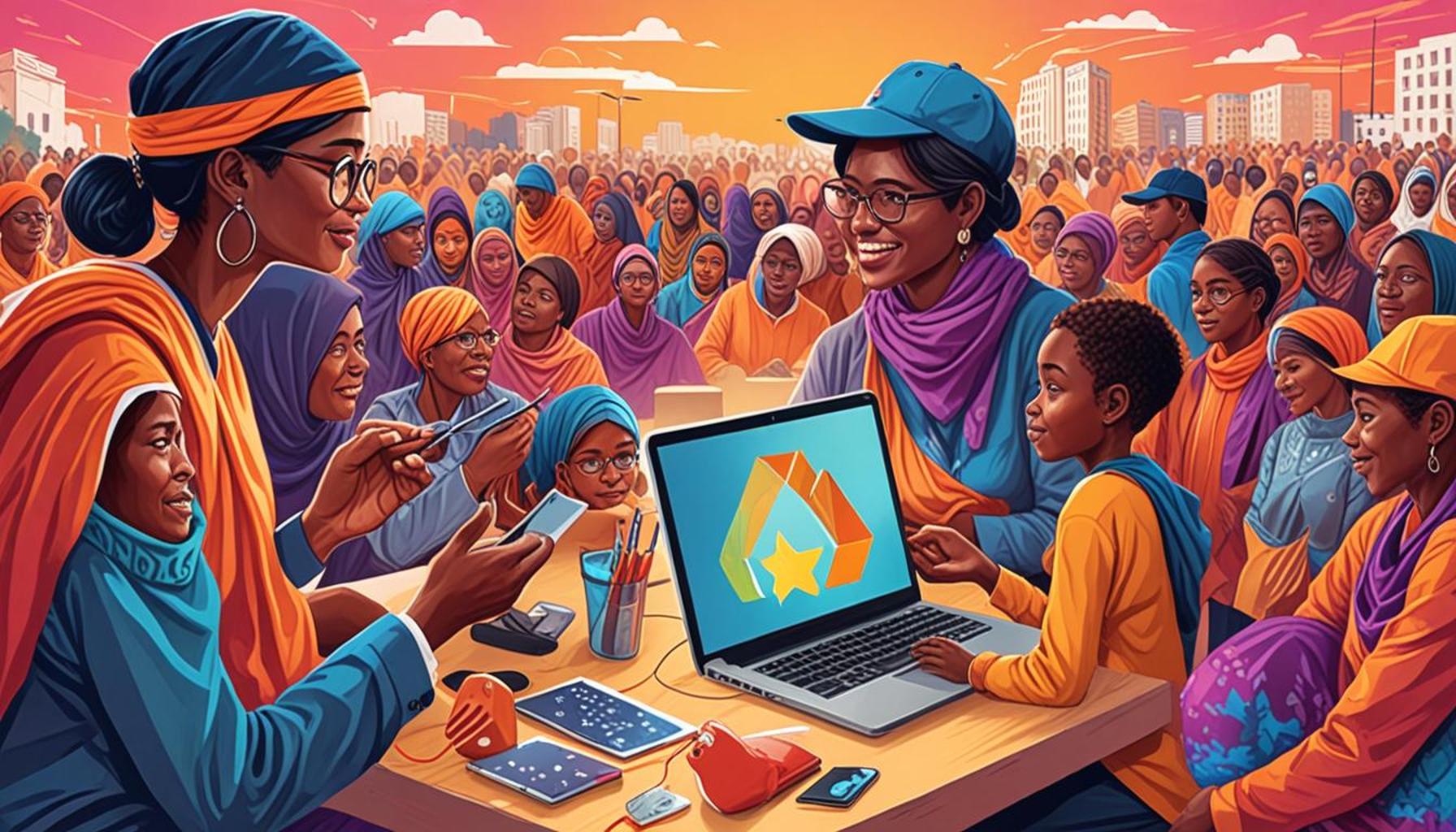The Importance of Digital Outreach in Accessing Government Benefits for Marginalized Communities

Understanding the Digital Divide
In a rapidly evolving technological landscape, digital outreach serves as a crucial bridge for marginalized communities seeking government benefits. Despite the increasing availability of online resources, many individuals remain unaware or unable to access these valuable services. According to recent data from the Pew Research Center, approximately 13% of Americans still lack a reliable internet connection, with this number being significantly higher in lower-income neighborhoods. This disparity highlights the urgent need for initiatives aimed at closing the digital gap.
Challenges Faced by Marginalized Groups
- Limited internet access in low-income neighborhoods: Many areas lack the necessary infrastructure, resulting in slow or unreliable internet connections. For instance, rural communities often endure hardships due to inadequate broadband coverage, which limits their ability to fill out important applications for government assistance online.
- Lack of digital literacy and familiarity: Many individuals, particularly older adults or those from non-technical backgrounds, may struggle with navigating online systems. Without basic skills, the digital landscape can feel overwhelming, leading to frustration and disengagement from essential services.
- Language barriers that hinder understanding of online services: The diverse population in the United States speaks a myriad of languages, yet most online resources and applications are primarily available in English. This creates a significant hurdle for non-English speakers, making it difficult for them to access the information they need.
These challenges contribute to a significant gap in access to vital programs such as food assistance, healthcare services, and housing support. For many, navigating these bureaucratic systems becomes an overwhelming task due to the absence of targeted outreach. A report from the U.S. Department of Agriculture indicated that many eligible families miss out on food stamps simply due to lack of information and support in the application process, deepening their struggles during economically challenging times.
The Role of Digital Outreach
Digital outreach initiatives have the potential to transform the landscape for these communities by:
- Providing tailored information about available benefits: Targeted campaigns can inform residents about specific programs relevant to their unique circumstances, ensuring they do not miss out on what they qualify for, such as the Supplemental Nutrition Assistance Program (SNAP).
- Creating user-friendly platforms for applications: Simplifying the application process through accessible design can significantly enhance participation rates. For example, the integration of mobile apps allows users to apply for benefits on-the-go, further breaking down barriers.
- Offering support through community engagement and workshops: Hosting local workshops can empower residents with the skills needed to effectively use technology. These community-driven efforts help build confidence and familiarity, fostering a sense of ownership over the application process.
By harnessing technology, advocates aim to ensure equitable access to government services for all. This shift not only empowers individuals but also fosters a more inclusive society. Communities can thrive when resources are distributed fairly and effectively, allowing every citizen the opportunity to secure essential services. Understanding the significance of these efforts is the first step toward a more balanced distribution of resources, paving the way for a society where every voice is heard and every need is met.
LEARN MORE: This related article may interest you
The Consequences of Limited Access
With the digital divide imposing significant barriers, the consequences of limited access to digital resources touch every facet of life for marginalized communities. Inadequate access to government benefits can exacerbate existing inequalities, leading to a cycle of poverty that is difficult to escape. As individuals and families miss out on essential aid, their circumstances may worsen, leading to increased stress and further marginalization.
Impact on Daily Living and Well-Being
The implications of restricted access extend beyond mere inconvenience. For many, government assistance programs are lifelines that provide food security, medical care, and financial support. Each missed opportunity can mean struggling to make ends meet. Frequent analysis reveals that low-income families often bear the brunt of this problem—approximately 63% of eligible families fail to access SNAP benefits due to a combination of known information gaps and systemic inefficiencies. These statistics serve as a reminder of the lives affected by the digital gap.
Broader Societal Implications
The exclusion of marginalized communities from digital outreach not only impacts individuals but also has wider societal ramifications. When large segments of the population remain disconnected from available services, society experiences a decrease in overall well-being and productivity. The recent pandemic has further highlighted this issue, as many essential services transitioned online, leaving those without digital access at a significant disadvantage. The digital divide can also contribute to increased healthcare disparities, as individuals struggle to access vital health information and services.
- Food Insecurity: A lack of access to online resources can hinder enrollment in food assistance programs, exacerbating food deserts.
- Healthcare Challenges: Individuals may miss out on telehealth services, resulting in untreated health issues and increased emergency room visits.
- Employment Barriers: Restricted digital access limits job opportunities, as many employers shift to online applications, further entrenching unemployment among marginalized groups.
Additionally, the fear of bureaucratic complexities often perpetuates disengagement from government programs. Many eligible individuals may not have the time or resources to navigate complicated systems without a helping hand. A study by the Federal Reserve indicated that over 40% of Americans reported feeling overwhelmed by the process of applying for benefits, signifying a critical need for comprehensive outreach strategies.
Recognizing the multifaceted impacts of limited digital access illustrates the necessity of prioritizing digital outreach as a means of connecting marginalized communities to government services. Ensuring equitable access to government benefits is essential for fostering not only individual empowerment but also building a society where resources are allocated fairly and efficiently. As advocates, policymakers, and community leaders strive to break down barriers, the hope is that every individual will have the opportunity to thrive, transforming the landscape for countless families across the nation.
| Advantage | Explanation |
|---|---|
| Increased Awareness | Digital outreach initiatives, such as social media campaigns, can vastly improve awareness of available government benefits among marginalized communities, ensuring that eligible individuals are informed about resources. |
| Improved Accessibility | With digital tools at their disposal, government agencies can facilitate easier access to applications and information, breaking down barriers that traditionally hindered participation by marginalized groups. |
Digital outreach not only enhances awareness but also signifies a crucial shift in how assistance is accessed. As more marginalized individuals navigate online platforms, the reliance on community resources reduces, marking a paradigm shift toward greater independence, while also promoting civic engagement. For instance, programs that leverage text messaging and social media can engage those who may not have access to conventional channels, thus enabling a wider reach and support for these communities. The use of digital methods allows government agencies to gather data more effectively, tailoring programs to better suit the needs of those they serve. As this digital landscape continues to evolve, so too does the potential to create significant positive impacts on resource accessibility for marginalized populations.
SEE ALSO: Click here to read another article
Strategies for Effective Digital Outreach
To address the urgent need for improved access to government benefits for marginalized communities, a robust strategy for digital outreach is essential. Engaging these communities requires an understanding of their unique challenges and leveraging technology to create meaningful connections. By employing targeted initiatives, we can close the digital divide and ensure that vital services reach those most in need.
Community-Centric Approaches
Understanding and integrating the cultural and contextual factors affecting marginalized communities is key to successful outreach. When designing digital outreach programs, agencies should prioritize partnerships with local organizations already rooted in these communities. Collaboration with grassroots organizations not only lends credibility but also helps tailor initiatives to the specific needs of the population. For instance, organizations like the United Way have successfully implemented programs targeting low-income households, utilizing local knowledge to streamline recruitment strategies and enhance service delivery.
Utilization of Social Media and Technology
Social media platforms are increasingly vital in reaching underserved populations, especially younger demographics. Crafting informative and engaging content can encourage individuals to explore available benefits. For example, a recent campaign by the U.S. Department of Agriculture utilized Instagram to demystify the Supplemental Nutrition Assistance Program (SNAP), providing clear and engaging visuals that explained the benefits, eligibility requirements, and application process. Such initiatives not only educate potential participants but also build community trust, making it easier for individuals to seek out assistance.
Mobile Accessibility and User-Friendly Platforms
According to the Pew Research Center, nearly 78% of lower-income households own a smartphone, underscoring the importance of ensuring that digital outreach is mobile-friendly. Government agencies must invest in creating user-friendly websites and mobile applications that facilitate easy access to benefits. Simplifying navigation and employing clear language are crucial in eliminating barriers for those who may be unfamiliar with technology. For instance, platforms like GetCalFresh in California have transformed the enrollment process into a seamless mobile experience, allowing applicants to apply for benefits in under ten minutes.
- Targeted Outreach Campaigns: Focused social media advertising can be employed to reach specific demographics that may benefit from government programs.
- Virtual Workshops: Hosting online events can educate communities on available resources, application processes, and eligibility criteria, further demystifying complex government systems.
- Multilingual Resources: Providing materials in multiple languages can bridge communication gaps and enhance participation among non-English speaking populations.
Measuring Impact and Community Feedback
Continuously assessing the effectiveness of digital outreach initiatives is necessary to refine strategies and foster accountability. Implementing feedback loops through surveys, focus groups, and community meetings can help agencies understand the efficacy of their outreach efforts. For example, programs that respond to community input have shown to improve trust and participation rates, leading to increased enrollment in government benefits. This, in turn, can contribute to improved overall well-being and reduce further marginalization.
As society becomes increasingly reliant on digital platforms, recognizing the importance of tailored outreach strategies will be essential in creating equitable access to critical government benefits. The integration of technology and an emphasis on community engagement is pivotal in transforming lives for marginalized communities, fostering an inclusive society where everyone can thrive. Together, stakeholders can dismantle the barriers created by the digital divide and promote access to essential resources needed to build brighter futures.
RECOMMENDED: Check out this similar article
Conclusion
In conclusion, dismantling the barriers to accessing government benefits for marginalized communities is an essential step toward fostering equity and inclusion in society. As digital platforms become the predominant mode of communication, effective digital outreach strategies play a critical role in bridging the gap between underserved populations and available resources. By prioritizing community-centric approaches, harnessing the power of social media, and ensuring mobile accessibility, we can create pathways that empower individuals to engage with vital benefits.
The commitment to utilizing targeted outreach campaigns and multilingual resources is not just about raising awareness; it’s about building trust within communities that often feel alienated from government services. Moreover, the emphasis on continual assessment and community feedback ensures that programs remain relevant and responsive, ultimately leading to increased participation in assistance programs. The collaboration between government agencies and grassroots organizations enhances this effort, by allowing for the tailoring of services that meet the specific needs of diverse populations.
As we move forward, investing in digital outreach is not merely an option—it is an obligation. The long-term well-being of marginalized communities and the overall health of society depend on our ability to innovate and adapt our outreach strategies. By prioritizing inclusive digital practices, we not only ensure that essential government benefits reach those in need but also foster a community where everyone has the opportunity to thrive. The path ahead calls for collective action, creativity, and compassion in transforming lives through effective digital outreach.



